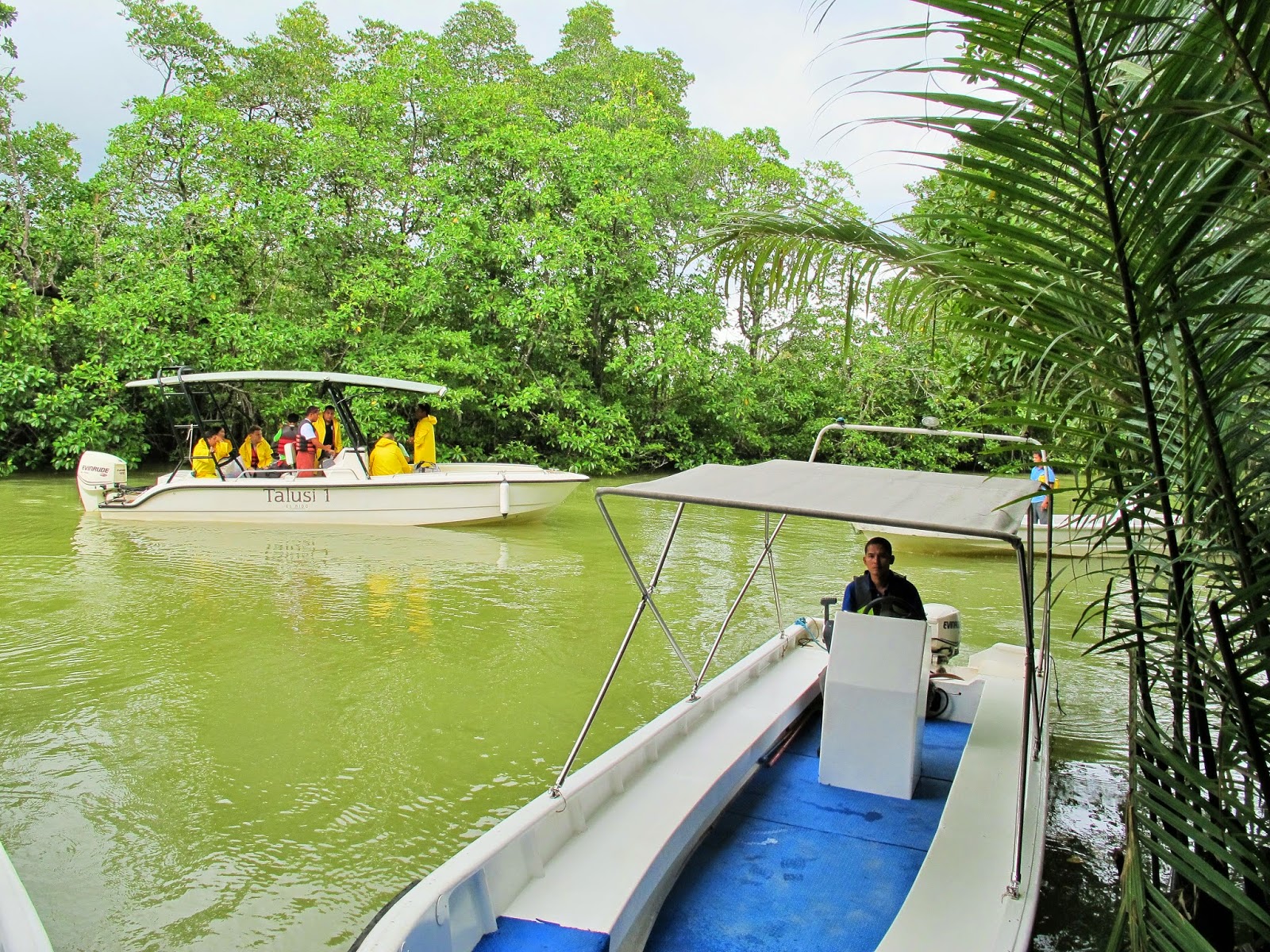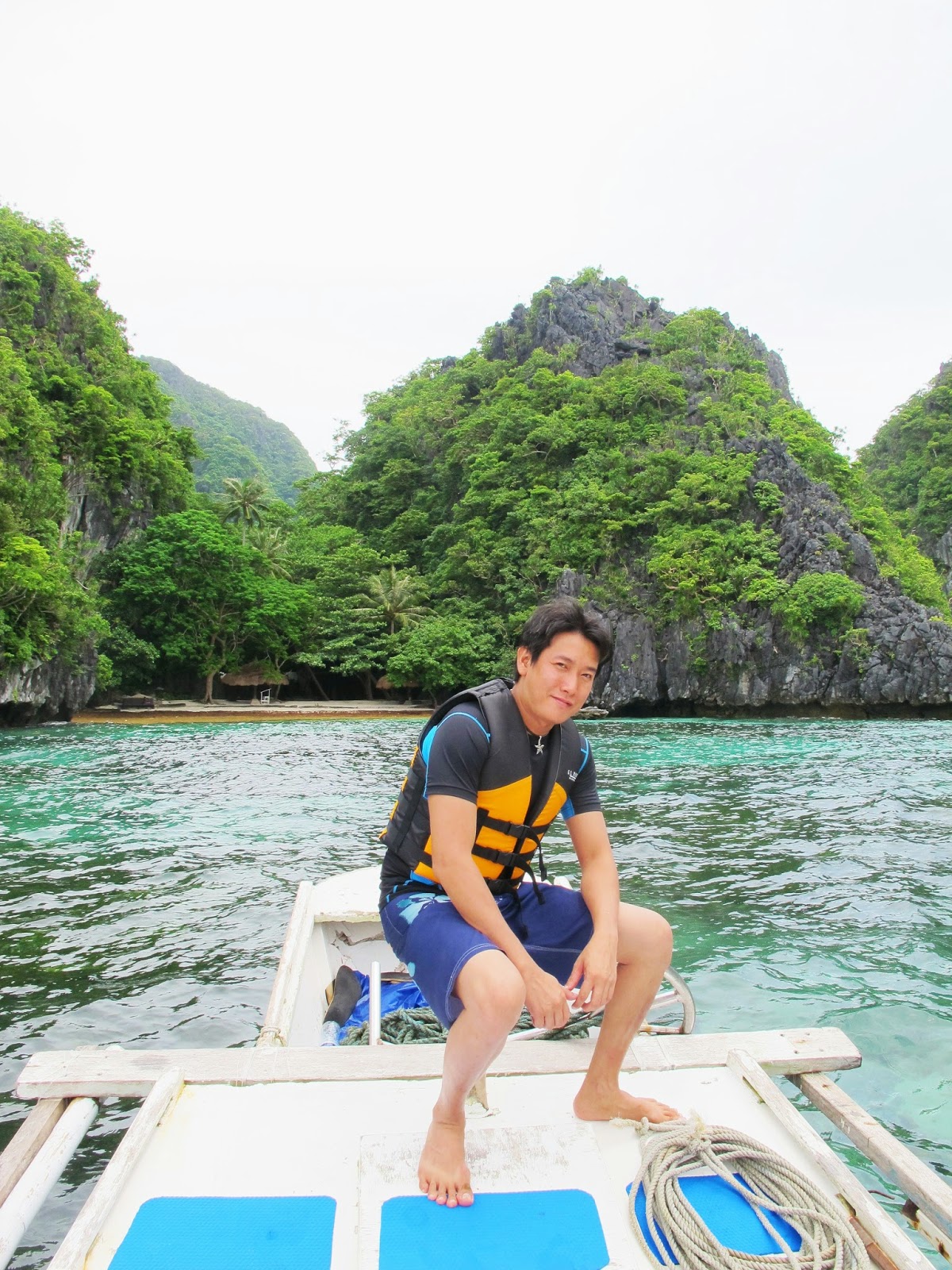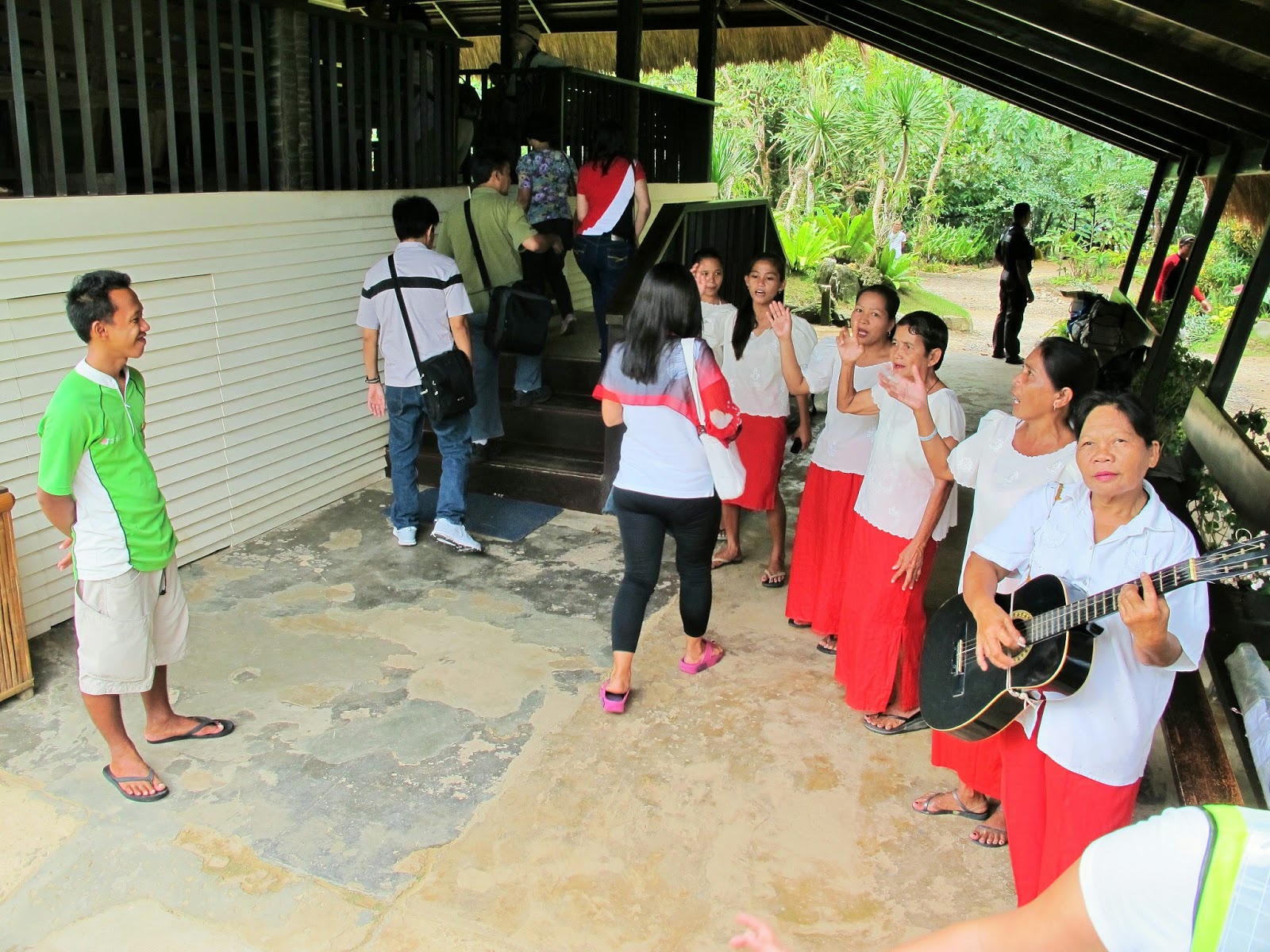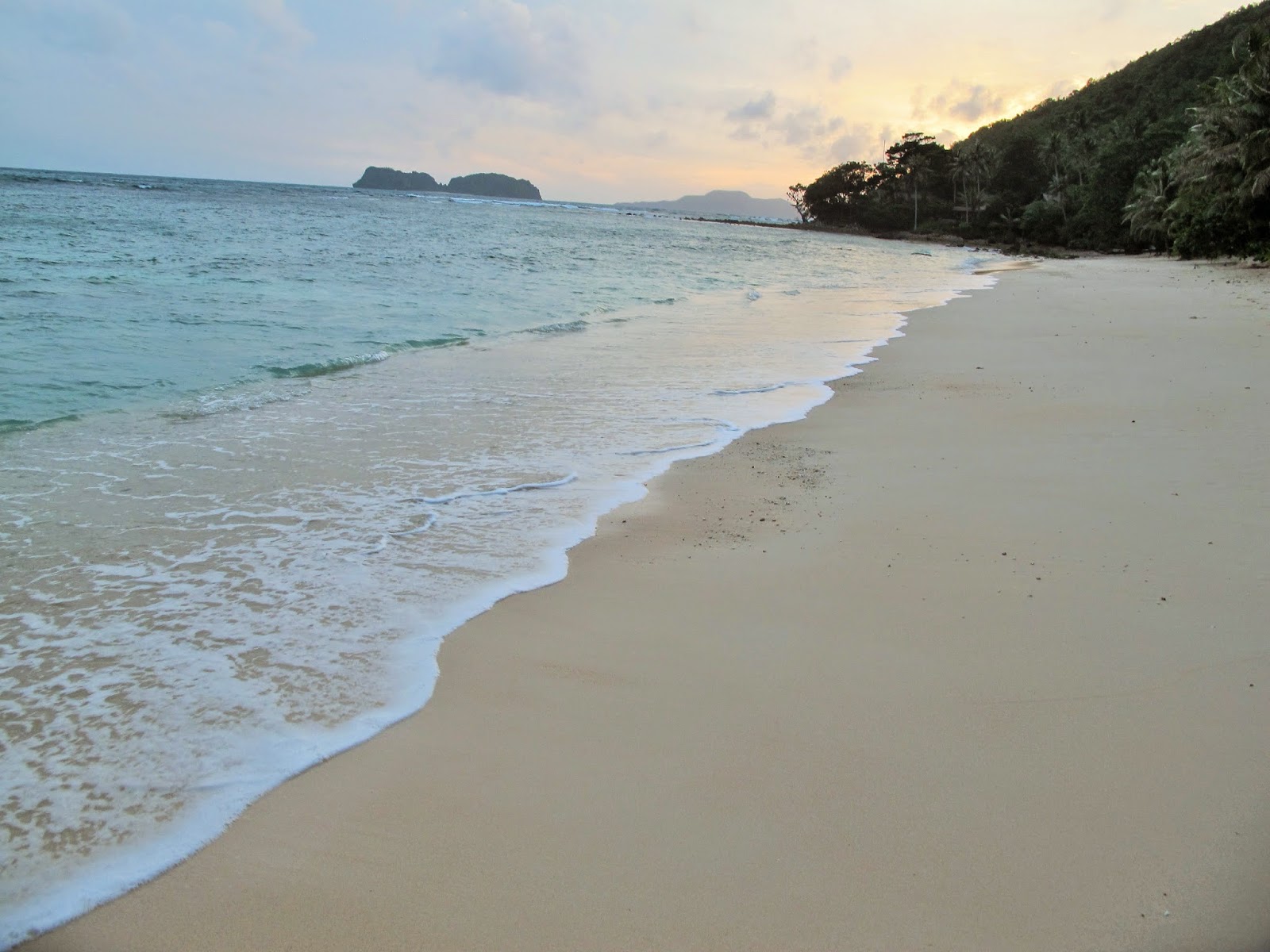 |
| Sunrise at the Miniloc Island Resort, El Nido. The iconic image of this resort as well as other properties of the El Nido Resorts is the cottages on stilts, over water. |
The nondescript, white gate at one
of the side streets of Andrews Avenue in Nichols, Pasay City, is a portal to a
place of wonder and adventure. I had the perennial Metro Manila nuisances to
hurdle several minutes before reaching that gate. Traffic can easily get
convoluted in the area, where there are several airports. Jams were starting to
build up and the fumes were rising to form a noxious blanket.
Mercifully, passing security and
checking in were a breeze. It was a tiny terminal anyway with no queues of
passengers and with more courteous personnel. It was actually in a hanger. Island
Transvoyager, Inc. (ITI) operates direct flights to El Nido and chartered flights
to other remote areas from the Andres Soriano Hangar.
The pre-departure lounge was small
but cozy with parquet floor, walls and ceiling accented with bamboo, wood and
wicker chairs, and a table laden with muffins, sandwiches, juices and coffee.
At the other side of the hangar was the lounge of Amanpulo Resort, the famous,
exclusive, luxury getaway. I was given a
boarding pass, a small piece of wood etched with the seat number.
 |
| The 19-seat Dornier plane back in 2011 |
 |
| Inside the plane |
 |
| The plane was so small you can actually see the cockpit |
 |
| Flying over Metro Manila |
 |
| The wooden boarding pass |
 |
| The pre-departure lounge in 2008 |
 |
| Views from the plane |
I remembered the first time I went
to El Nido in 2008. It was like a vivid dream from the start, at the airport,
until the end. The plane was a small nineteen-seat Dornier 228. The flight
attendant had to demonstrate safety instructions at the longue. Inside the
aircraft, there were more crates of fruits and vegetables than passengers. It
felt like a classic expedition into the wild and the exotic. Up in the air, I
could feel the friction between the small aircraft and the rushing wind
outside, exacerbating the ache in my ear which I tried to dismiss by sleeping.
Flying south of Manila and passing the island
of Mindoro, the view from the window was the endless expanse of sea until. After
about 400 kilometers, we were flying over the northwestern part of Palawan.
Peering through the haze of somnolence and veils of clouds, I could make the
outlines of islands, shores and coves, appearing like streaks of a finely cut
blue agate. It felt like waking up to a dream—a gleaming blue sea studded with
islets and atolls, and hills emerald with forests, places difficult to imagine
what they look like on ground, villages that seemed isolated in coves and
islands, roads that disappeared into mountains, white-sand shores that seemed
deserted.
At a lower altitude, the islands showed up one
by one, several in strange shapes, with their wreaths of vegetation. The sense
of adventure and the feeling that we were in one of the most beautiful places
on Earth intensified as we approached and crystallized as we landed. ITI now
flies ATR 42-500 aircrafts that can carry fifty passengers, more comfortable
but no less exciting.
Also operated by ITI, the Lio Airport is a
1,120-meter runway in the middle of, well, nowhere. It is hemmed in by tracts
of forests and grasslands of the barangay
of Villa Libertad. At one end are the verdant hills and the other the expansive
sea. A red carpet was laid out on the runway for the alighting passengers,
bright and conspicuous among the crude gray and rustic green and brown. There
was something amusing and charming about this piece of luxury in the midst of
the rough and the natural, but one will find that it is a recurring thing
throughout a stay at the El Nido Resorts (ENR), which thrusts one into the
middle of El Nido’s still unspoiled natural beauty but coddles one with modern
comforts.
 |
| Snacks of puto and suman await guests at the Lio Airport terminal |
 |
| The welcome troupe singing folk songs. |
 |
| Bust of Jose Rodriguez Seastress, once mayor of El Nido who gave invaluable support to Ten Knots. |
 |
| The terminal at Lio Airport in El Nido is a couple of large grass-roofed huts. |
 |
| A speedboat for ENR guests at the Lio River |
 |
| The jetty port at the beach near the airport |
 |
| The islands of Bacuit Bay |
Perhaps, the best way to experience the beauty
of El Nido is through the El Nido Resorts, which manages three resorts on three
of the islands of Bacuit Bay. And the Bacuit Bay area with its islands and
islets and the surrounding shores and coves is perhaps the most picturesque
part of the town.
The town of El Nido occupies an area of 465.1
square kilometres at the northern part of the island province of Palawan, which
is frequently regarded as the Philippines’ “last frontier” because of its
relatively undisturbed flora and fauna. To many, Palawan is most known for the
Puerto Princesa Underground River, a United Nations Educational, Scientific and
Cultural Organization (UNESCO) World Heritage site and the province’s prime
tourist attraction. Coron at the northern tip is another popular tourist
destination. Next to them will be El Nido. Many resorts and lodges have
sprouted at the town proper, where most of the town’s population of about 36,000
reside. The town proper nestles at the southernmost cove of El Nido Bay, a
small strip of houses against limestone cliffs. Though I had not stayed at the
town proper, I got glimpse of it on my second visit. I came from Apulit Island
Resort, another El Nido Resorts property, formerly the Club Noah Isabelle
Resort, in the neighboring town of Taytay. The trip to El Nido took about two
hours, mostly on rough roads, and afforded a view of the northern Palawan
countryside. The trip culminated with being charmed by the El Nido town proper,
a community thriving among dramatic limestone cliffs. Most of the visitors to
El Nido go through the capital Puerto Princesa, about 238 kilometres to the
south, about seven- to eight-hour bus ride. ENR guests are serviced by ITI,
which also accommodates regular travelers.
At Lio Airport, a customized jeepney suddenly
appeared to fetch passengers and bring them to the terminal, which is actually
a couple of large huts, one for arrivals and one for departures. A band of old
women in traditional costumes greeted arriving passengers as well as bid
departing ones farewell with folk songs. A carabao once accompanied them
before. Local sweets—usually puto (rice
cakes) and suman—were offered inside
the terminal. Already, a guide from ENR will also be waiting, and most likely
he will be with you all throughout your stay, arranging excursions, answering
questions and generally making your trip as hassle-free as possible.
Behind the terminal is the Lio River where a
speedboat waited for resort guests. It would ferry them through the river
fringed with lush growths of mangrove out to the bay where a larger outrigger
boat to which guests will transfer. During low tide, one goes to beach, lovely
in its desolation, where there is a large makeshift pier and walkway of wood
planks. A boat waited at the end, the start of a journey of wonder.
Bacuit Bay is heralded by its biggest island, Cadlao.
The 1,006-hectare island also has the Bacuit archipelago’s highest peak, which
rises to 609 meters above sea level. Its pockets of white-sand beaches, lagoons
and forest cover attract many excursionists. Its name can be very apt; it means
“smile” in Cuyunon, the local language.
The islands of Bacuit Bay never fail to inspire
awe. About 45 islands and islets with their interesting flora and fauna are
strewn in the bay, which connects to the South China Sea and the Sulu Sea. The
Linapacan Strait lies to its north. Made mostly of limestone, they look like
hills and mountains floating on the sea, with caves, beaches, lagoons, forests and
diving sites that all the more lure people like mermaid songs. These limestone cliffs are believed to be 250 million years old,
carved out of thick coralline deposits in the sea covering what is presently North
Vietnam and South China. About 60 million years ago, tectonic upheavals brought
them out of the sea and placed them where they are today.
Bacuit is the old name of the area, given in
1890 when the Spaniards settled here and organized the town. In 1954, it was
changed to its present name, El Nido, meaning “the nest” in Spanish. As the
boat goes through the islands, one can see why. Along the way, we saw small
makeshift huts perched among the cliffs near caves and large crevices of some
of the islands. Busyadores or nest
gatherers staked their claims on the caves. Swiftlets come to El Nido and
Taytay in certain seasons to mate, build nests and lay eggs. The nests are made
purely from their saliva and are a treasured ingredient in Chinese cuisine and
medicine. Nest gatherers clamber on rocks and rudimentary bamboo scaffoldings
to harvest the nests, which are sold at about US$ 3,000 per kilogram.
Here in Bacuit Bay, the Ten Knots Development
Corporation maintains three resorts in three separate islands. The resorts not
only offer places to stay, with all the amenities expected of a world-class
haven, but also access to the wonders of the area and an experience that will burn
in the soul. Moreover, they involve those who stay with them to care for the
environment as much as the people behind the resorts, something that has earned
them respect and accolades worldwide.
 |
| One of the first structures at the Miniloc Island Resort |
 |
| Miniloc Island Resort |
 |
| Miniloc Island Resort staff welcomes guests with songs and dance |
 |
| Miniloc Island Resort's Water Cottages |
 |
| Miniloc Island Resort |
 |
| Miniloc Island Resort's bar |
 |
| Dinner at Miniloc Island Resort's Payong-Payong Cove |
 |
| Miniloc Island Resort's restaurant |
 |
| Mullets at the Miniloc Island Resort |
 |
| ENR guests have woven bags, the Eco-Nido Bag, plastic bags and guides in their rooms |
At the heart of Bacuit Bay
archipelago, surrounded by the islands of Paglugaban, Entalula, Matinloc,
Inambuyid, Guintungauan and Dilumacad, Miniloc Island is the first home of the
Ten Knots resort. Set against limestone cliffs, a cluster of rustic cottages
stand on the white-sand shore of one of its coves, some jutting out to the sea,
at the eastern side of the island. Being about 30 years old, some cottages of Miniloc
Island Resort show their age, still retaining its make of mostly bamboo,
coconut and grass, but remain well-maintained and charming. In some ways, a
cottage looks like a local fisherman’s hut only with resort amenities.
I was told that those who started the resort
were divers, on board their dive boat Via
Mare, who ventured into El Nido. They built cottages in which to stay while
exploring the area. Ten Knots, named after the belief “that ten knots is the
ideal speed not only in getting to their dive destination quickly, but also
cruising leisurely enough to appreciate and enjoy Nature’s endowments,” became
a group of companies that includes one that focuses on property management. Then
Filipino-American company Asian Conservation Corporation (ACC) became involved in
the venture in 2004. In 2010, major property company Ayala Land, which is
furthering its tourism forays, went into a joint venture with ACC, securing a
sixty percent share. With Ayala Land, El Nido Resorts added the Apulit Island
Resort in Taytay and built another resort, the Pangalusian Island Resort, which
is the most luxurious in the area.
Meanwhile, the fifty-room Miniloc Island
Resort retains history as well as builds new facilities and rooms. Cottages
stand over water on stilts, surrounded by tropical plants or perched high on
the hillside. Near the resort is a small cove the staff calls Payong-Payong,
literally “umbrella” in Filipino, where a private dinner can be set up.
The second resort in Lagen Island is
nearer to the Palawan mainland. Opened in 1998, the Lagen Island Resort,
situated in a cove in the northeastern part of the island, has a more modern
feel and boasts of upscale accommodations surrounded by landscaped gardens. It
has also has fifty rooms—Water Cottages built on stilts on both sides of its
cove, Beachfront Cottages with a view of the entire cove, Forest Rooms and
Forest Suites built on the fringes of a tropical forest, all amply furnished for
a comfortable stay. Additionally, Lagen Island’s clubhouse houses the
air-conditioned main dining area which serves buffet and a la carte meals. On
the lower level are the boutique, game area, library, clinic and conference
room. In the middle of the resort is the swimming pool and a spa, providing a
view of the sunset. The marine sports center has a complete line of diving and
snorkeling equipment, as well as kayaks, windsurfs and Hobie cat. Behind Lagen
Island, there is a sandbar where private dinner can be set up. Lagen’s iconic
picture is a lunch set-up with a white umbrella and the white sand gleaming,
the islands providing a pensive background.
 |
| The verandah of a Water Cottage at the Lagen Island Resort |
 |
| Port at the Lagen Island Resort |
 |
| Bathroom of a Forest Suite at the Lagen Island Resort |
 |
| Forest Suite at the Lagen Island Resort |
 |
| Forest Suite at the Lagen Island Resort |
 |
| Forest Suite at the Lagen Island Resort |
 |
| Forest Suite at the Lagen Island Resort |
 |
| Forest Suite at the Lagen Island Resort |
 |
| Forest Suite at the Lagen Island Resort |
 |
| Forest Suite at the Lagen Island Resort |
 |
| Forest Suite at the Lagen Island Resort |
 |
| Lagen Island Resort |
 |
| Lagen Island Resort |
 |
| Lagen Island Resort |
 |
| Lagen Island Resort |
 |
| Lagen Island Resort |
 |
| Lagen Island Resort pool |
 |
| Lagen Island Resort pool and restaurant |
 |
| Lagen Island Resort pool |
 |
| Lagen Island Resort pool |
 |
| Lagen Island Resort |
 |
| Lagen Island Resort pool |
 |
| Lagen Island Resort pool |
 |
| Lagen Island Resort pool |
 |
| Lagen Island Resort reception area |
 |
| Lagen Island Resort restuarant and other facilities |
 |
| Lagen Island Resort buffet |
 |
| Steamed mud crab for dinner |
 |
| Salad and kimchi |
 |
| Lagen Island Resort restaurant |
 |
| Lagen Island Resort restaurant |
 |
| Lagen Island Resort Forest Suite room |
 |
| Fruits and messages at Lagen Island Resort |
 |
| Lagen Island Resort's Forest Suites |
 |
| Lagen Island Resort |
 |
| Lagen Island Resort restaurant |
 |
| Lagen Island Resort restaurant |
 |
| Arranging a photo shoot of Lagen Island Resort's sandbar despite the rain |
 |
| The private lunch setup at the sandbar of Lagen Island Resort |
 |
| Lagen Island Resort |
 |
| Lagen Island Resort's spa |
 |
| If you want a laidback activity, guides can teach you to make hats out of coconut leaves. |
 |
| At Lagen Island Resort, a monitor lizard swims at the pool almost every morning and then slithers its way to the forest pass some of the rooms |
The ENR maintained the Pangalusian
Beach Club on Pangalusian Island, just across Lagen, where guests can have
lunch, but it was gutted by fire in 1998. The island is the site of one of the
early resorts in El Nido, built by former owner, the Gordon family, in 1982.
The island was then acquired by Ten Knots. Now, Pangalusian Island Resort stands
on the island’s 750-meter white-sand beach, at the southeastern side, where
both sunrise and sunset can be observed in their majesty. Before the sun set,
we visited its villas, awed by their sheer beauty and luxury.
 |
| Pangalusian Island |
 |
| The Pangalusian Island Resort |
 |
| The Pangalusian Island Resort |
 |
| The Pangalusian Island Resort |
 |
| The white sand beach at Pangalusian Islan |
 |
| Bathroom at one of the villas of the Pangalusian Island Resort |
 |
| A Pangalusian Island Resort villa |
 |
| Beach in Pangalusian Island |
 |
| The Pangalusian Island Resort |
The most enduring image of these
resorts, except for Pangalusian the newest, is the series of cottages standing
on stilts over the water, against the limestone cliffs, a beautiful merging of
the luxurious and the rough, the elegant and the wild. One can retreat to the
air-conditioned comfort of the room and take a few steps outside to be so near
forests and exotic animals.
In Miniloc Island Resort, large diamond-scaled
mullets or banak swim under the
cottages and about the cove, which has an average depth of eight meters. They
are considered pets, delighting guests who often snorkel with the fish. In Lagen,
parrot fishes and puffer fishes swim around sea cucumbers. Above, hornbills or kalaw come to roost on branches. In
mornings, a monitor lizard takes a dip in the swimming pool. As night descends,
dissolving the limestone islets and leaving only few flickering lights, Lagen
Island Resort becomes a forest lit with lamps hanging from trees. At one part,
different insects chirp and sing and at the other the waves crash against the
rocks. Above, fruit bats launch into their nocturnal forays, and you are at the
center, floating on a soft bed that carries you to the land of dreams.
There are more beautiful creatures.
You are given an “eco-checklist” together with the Eco-nido bag in which to put
non-biodegradable trash and a woven buri
bag for belongings. The illustrated checklist is a favorite, in which one can
log in the species one spots. The information will be added to the resort’s
database. Listed are the whale shark, parrotfish, the clownfish, the jack, the
black-tipped reef shark, the giant clam, the crown of thorns, the barrel
sponge, the feather star, the sea urchin, the Bryde’s whale, the bottle-nosed
dolphin, the Palawan squirrel, the long-tailed macaque, the Tabon scrub fowl,
the green sea turtle, the hawksbill turtle, the water monitor lizard, the
banded mangrove snake, the grey imperial pigeon, the Palawan hornbill, the
lesser frigate bird, the eastern reef egret, the white-breasted sea eagle and
the black-naped tern.
 |
| Entalula Island |
 |
| Entalula Island lunch |
 |
| Dibuluan Island |
 |
| Dibuluan Island |
 |
| ENR beach house in Dibuluan Island |
 |
| Dibuluan Island |
 |
| Buffet lunch in Dibuluan Island |
Days are spent outside going from
island to island. ENR offers a host of activities— hiking on forest trails, visiting
lagoons and caves, mangrove river tours, bottom fishing, bird watching, hat
making, picnic lunches, sunset cruising, kayaking, windsurfing, Hobie cat
sailing, snorkeling, and diving.
One of the highlights of El Nido is a visit to
the Big and Small Lagoons—a spectacular, almost surreal venture—in Miniloc
Island. The lagoons are located on the northeastern side of the island. A
narrow channel with soaring limestone cliffs on both sides served as passageway
to the Big Lagoon. Along the way, we saw congregations of sea urchins, a couple
of baby sharks and a monitor lizard. We kayaked around the lagoon, our voices
echoing through the silence. Most of the time, we were silent in awe. To get to
the Small Lagoon, we had to kayak our way though a small opening. During high
tide, we might have to swim underneath or have to lie down on our kayaks. We
were rewarded with another place of beauty. I was reminded of the Suhoton Cove
in Surigao del Norte.
Another popular destination is Vigan Island at
the southern part of the bay. The small islet has a long, winding sand spit
that disappears during high tide, earning the popular name Snake Island. Our
boat docked along the sand spit, on which we walked to the top of the island
where pitcher plants thrive. Curiously, pitcher plants can be found nowhere
else in Bacuit Bay.
Near Vigan is Cudugnon Cave, already on the
Palawan mainland, where excursionists crawl though a small opening into a dry chamber
with skylight. Guides often describe it as a Neolithic burial place, where ancient
artifacts have been unearthed. The islet of Pinasil also has a cave, also
frequently visited only via a boat, this one cathedral-like.
In between swimming and island-hopping, we had lunches
at ENR’s beach houses in Entalula Island and Dibuluan Island, where there are
white-sand beaches to swim in and a limestone cliff to tackle. One can sail a
Hobie cat, kayak, windsurf, or play volleyball or badminton.
The activities remain to have low impact on the
environment. Aside from the facilities and service, another admirable thing
about the El Nido Resorts is its commitment to the local community and the
environment. A large part of ENR’s charm owes much to the surroundings. Since
its establishment, ENR has played a substantial role in the environmental
efforts in the area with its own initiatives, partnerships with several
agencies and establishment of the El Nido
Foundation.
Guests are always made aware of the environment and are encouraged to
participate in its preservation. The resort personnel are knowledgeable, able
to identify animals and plants in the area. Learning becomes as pleasurable as
the excursions, the picnics and the lounging here.
At the end of the trip, you are changed
somehow, even with just three days. Even with already three visits, there is
still much to explore and learn. As our boat set out to sea, the staff gathered
at the pier to sing and wave goodbye, not stopping until we disappeared in
sight. We passed by a large gray rock. A plant has sprouted from a crevice. The
sky turned gunmetal gray with threat of rain, but the somberness was brightened
by a surprising thing. Instead of leaping fishes, little brown butterflies
accompanied us, bravely flitting among the waves, going from one island to
another in search of nectar. We were reminded how resilient life can be, but at
the same time fragile, disappearing without us even knowing.
As the plane takes off and the clouds envelop
the place you have been, you organize the memories and look out the window. As
much as solid as a rock and rousing as seawater El Nido is, it will always be a
never-ending dream, set in lapis and emerald, precious and precarious.
Contact
Information
The El Nido Resorts’ Metro Manila office at the
18th Floor, 8747 Paseo de Roxas Street, Salcedo Village, Makati City. Contact
telephone number (+63 2) 813-000; or fax number (+63 2) 759-3957. Its e-mail
address is holidays@elnidoresorts.com. Check out Web site www.elnidoresorts.com. ENR has Facebook and Twitter accounts.
 |
| Me at the Small Lagoon |
 |
| Me trying to wind-surf |
 |
| Kayaking at Small Lagoon |
 |
| With the El Nido jeepney |
 |
| At Pinasil Cave |
 |
| In Vigan Island |
 |
| Departing for Metro Manila |






















































































































































































































































No comments:
Post a Comment